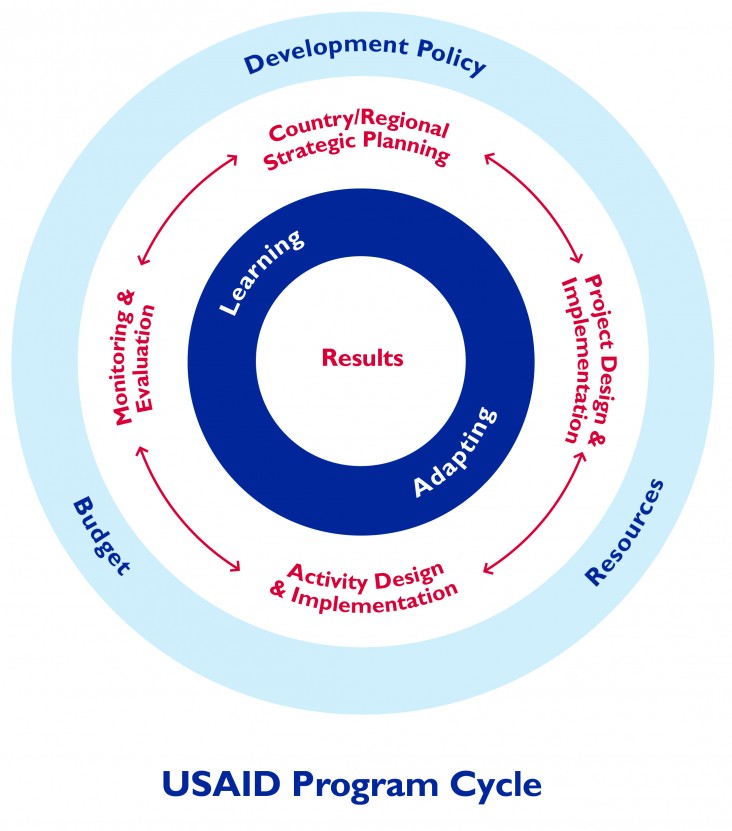Strategic planning and policy improvement is a top priority at USAID.
Our day-to-day activities are constantly informed and guided by this and other carefully crafted guidance frameworks:
- USAID Policy Framework: provides our staff and partners worldwide with a clear sense of our core development priorities
- Quadrennial Diplomacy and Development Review (QDDR): an unprecedented joint review of USAID and Department of State capabilities
- USAID and Department of State Strategic Plan FY 2014-2017: outlines the USAID and Department of State strategic goals and objectives for the period FY 2014-2017
- Management Initiatives and Cross-Cutting Goals issued by the Federal Government
- Agency Priority Goals are published on Performance.gov and accessible to the public.
All of our efforts are aimed at modernizing and strengthening USAID so that it can meet the most pressing development challenges and work more efficiently towards our ultimate goal—creating the conditions where our work is no longer needed.
Evidence-Based Approach
As a premier development agency, USAID must make strategic choices that are informed by experience and cutting-edge evidence and analysis.
The Program Cycle
The Program Cycle, codified in the Automated Directive Systems (ADS) 201 chapter, is USAID’s operational model for planning, delivering, assessing and adapting development programming in a given region or country in order to achieve more effective and sustainable results to advance U.S. foreign policy.
The Bureau for Policy, Planning and Learning introduced the Program Cycle in 2011 as a framework to link together the fundamental components of the Agency’s programming:
- Country/Regional Strategic Planning
- Project Design & Implementation
- Activity Design & Implementation
- Monitoring & Evaluation
- Collaborating, Learning & Adapting

A Principles-Based Approach
The following principles are essential for good development and serve as the foundation for ADS 201. These principles also support successful implementation of the Program Cycle:
- Apply analytic rigor: Make strategic choices based on conclusions supported by evidence.
- Manage adaptively: Make adjustments in response to new information and context changes.
- Promote sustainability: Generate lasting changes that can be sustained by local actors.
- Utilize diverse approaches for increased flexibility: Use a range of modalities to address diverse development challenges.
Country Development Cooperation Strategy
Strategic planning is the process to determine the best strategic approach in a given country or region. It is based on U.S. development policy priorities, country and/or regional priorities, and USAID’s comparative advantage and available foreign assistance resources, among other factors.The strategic planning process results in a Country Development Cooperation Strategy (CDCS).
Project Design
Project design is the process for defining how to achieve results to ensure that efforts are complementary and aligned in support of a strategy. Each project design typically incorporates multiple activities organized around, and implemented to achieve, a common purpose. The process also ensures that projects define a clear logic and purpose, are based on evidence of what works, and develops detailed plans for evaluation, monitoring and learning.
Monitoring
Monitoring is the ongoing and systematic tracking of information relevant to USAID strategies, projects and activities to support adaptive management and accountability structures at the Agency. Monitoring tells us whether implementation is on track and whether results are being achieved.
Monitoring Plans for strategies, projects and activities guide the efforts of USAID staff and implementing partners to ensure relevant information is available when needed to make adjustments to programs as well as to report to stakeholders.
Evaluation
USAID has made an ambitious commitment to quality program evaluation - the systematic collection and analysis of information as a basis for judgements to improve effectiveness and timed to inform decisions about current and future programming. USAID uses these program evaluation findings to inform decisions, improve program effectiveness, be accountable to stakeholders and support organizational learning.
Collaborating, Learning and Adapting
Strategic collaboration, continuous learning and adaptive management link together all components of the Program Cycle. Sources for learning include data from monitoring, portfolio reviews, findings of research, evaluations, analyses conducted by USAID or third parties, knowledge gained from experience and other sources. These sources should be used to develop plans, implement projects, manage adaptively and contribute to USAID’s knowledge base in order to improve development outcomes. A Collaborating, Learning and Adapting (CLA) focus helps ensure that programming is coordinated together, grounded in evidence and adjusted as necessary to remain relevant and effective throughout implementation.
Budget Management
Annual budgeting involves reconciling and prioritizing many objectives and constraints at multiple levels.
Given the fluidity of the process, CDCSs do not serve as final budgets. Instead they serve as directives over the annual budget process by rationalizing judgments of the relative value of assistance options within a country and region and across operating units.
Bureaus continue to play a key role in the budget formulation process, taking into consideration key country and functional priorities. During budget formulation and allocation, Regional and Sector Bureaus highlight the links between resources and results, and provide a brief analysis of the degree to which their recommendations align with approved CDCSs and projects. This information is used in budget reviews to try to maximize development results within budget constraints.







Comment
Make a general inquiry or suggest an improvement.